Introduction
Rates of obesity have elevated in recent decades according to the Centers for Disease Control and Prevention (CDC). The study has found out that the rate of obesity in children has doubled while that in adolescents has quadrupled. In addition, children who are obese are more likely to become obese in their adulthood if they do not exercise and maintain healthier methods of eating. There is also the likeliness of this leading to a rise in many health complications such as heart disease, diabetes and certain types of cancers.
Keywords: Obesity, children, an adolescent.
BMI of Children and Adolescents: Ages 2 to 19
BMI Classification
- At 85th Percentile and above on CDC growth charts Overweight or Obesity
- At 95th Percentile or above on the CDC growth charts Obesity (including extreme obesity)
- At 120 Percent or above, of the 95th percentile on CDC growth Extreme obesity
A relatively large and fairly consistent body of evidence now demonstrates that overweight and obesity during childhood and adolescence have adverse consequences on premature mortality and physical morbidity in adulthood. Higher chances of premature death and disability in adulthood may be as a result of childhood obesity (World Health Organization[WHO], n.d.).
The Pen-3 Model
The need for intervention in health promotion and disease prevention triggered the formation of the PEN-3 model which would make culture a big determinant of health behaviour. The intervention ought to be culturally specific. The PEN-3 model comes in handy to provide a standard procedure that creates a cultural framework by analyzing and organizing the community's cultural components in the planning process.
Cultural Identity
Culture refers to the shared beliefs, values and practices of a given group of people. Culture is a very important factor in such studies because it can largely influence different peoples' thoughts, acceptance and feelings about health education and practice. It may also be responsible for how they adopt such practices.
While food is considered to be a huge part of the culture, culture is better interpreted in terms of its beliefs, fears and preoccupations rather than by the food. Food is very important since it is a basic need which is needed on a daily basis for the body systems to function appropriately. Food is also a key component in celebrations and rite of passage ceremonies. Groups of people can be easily distinguished from their dietary patterns.
Cultural Empowerment
Empowerment means the measures put in place to increase self-determination, autonomy and self-dependence in individual persons or the community at large. Empowerment results into a people that represent their interests confidently, responsibly and in a more determined way. This kind of personal power allows individuals to operate on an individual level, thereby leading to self-understanding.
Self-empowerment depends on a sense of choice and control plus other factors such as a need to feel safe and connected, as well as the development of a sense of meaning and coherence in an individual. Self-empowerment dictates that for people who are obese and overweight, losing weight should not be the principal aim, but instead be a desirable result of personal awareness and hopefulness.
Relationship and Expectations
Overweight teens were found to be more prone to have body dissatisfaction and the Emergency Department(ED) disorder. Not only is body dissatisfaction a big risk factor, but it also increases by 14 times, the chances of developing such disorders. The entire families of adolescents should be involved by the health professionals in this process. The focus should mainly be on their change of behaviour and lifestyle. They should be given favourable conditions to enable them to enhance their nutritional state and their self-esteem, thus discouraging any behaviours likely to contribute to ED.
Conclusion
Culture is a key factor in influencing the diagnose and the treatment of obesity and overweight. This may be due to the existence of unrelated social norms and biological factors. Health care providers should be in a position to identify the differences between their own beliefs, cultural values, and practices, and those of the patients in order to create a positive connection. The positive connection leads to better healthcare provision.
References
World Health Organization, n.d. Global strategy on diet, physical activity and health. Retrieved on May 10, 2019, from
https://www.who.int/dietphysicalactivity/childhood_consequences/en/.
Cite this page
Essay on Weight Loss Intervention for Obese and Overweight Children and Adolescents. (2022, Mar 23). Retrieved from https://proessays.net/essays/essay-on-weight-loss-intervention-for-obese-and-overweight-children-and-adolescents
If you are the original author of this essay and no longer wish to have it published on the ProEssays website, please click below to request its removal:
- The Hmong - Essay Sample
- Adjusting to Terrorism Essay Example
- Huntington Disease - Essay Sample
- Essay Example on Masculinity in Guyland: Toxic Behaviour Towards Women
- Distracted Driving in Florida State Essay
- Essay Example on Displaced Persons: Internally Displaced & Refugees
- Learning Disability - Essay Example







